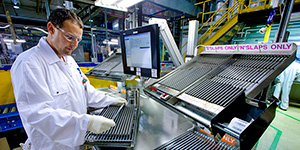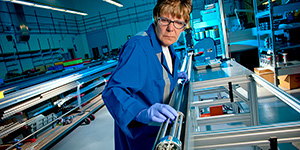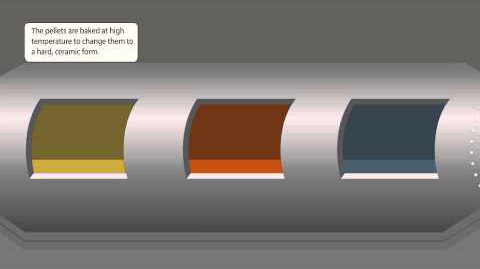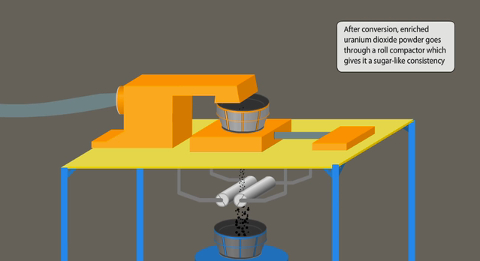The Final Stage of Processing

Fuel manufacturing is the last stage of processing before uranium fuel is ready for use in a reactor. The process begins by pressing either natural or enriched UO2 powder into small cylindrical shapes, measuring about 10 - 13 millimeters in length and 8 - 13.5 millimeters in diameter. These pellets are then baked (sintered) at a high temperature (1600 – 1700°C), where they acquire their characteristic strength and density. Each pellet weighs only about 10 grams, but can release as much energy as about 17,000 cubic feet of natural gas.
The pellets’ surface areas are then ground and finished to precise dimensions to ready them for insertion into fuel assemblies. UO2 removed during the grinding process is recycled back through the pelleting circuit.

From pelleting, the uranium moves into assembly.
Nuclear fuel bundle designs require precise physical rod arrangement in terms of spacing, and relation to other assembly features such as moderator and control-rod channels. The physical structures are engineered with extremely tight tolerances. They must be resistant to chemical corrosion, high temperatures, large static loads, constant vibration, fluid and mechanical impacts for about 12 to 18 months of continuous reactor operation.
The two most common types of fuels fabricated are for light water reactors (either pressurized water or boiling water) and heavy water reactors (CANDU type).
Light Water Reactor Fuel Assembly
Enriched uranium fuel pellets (about 300) are packed in thin, four meter tubes called fuel rods made of zirconium alloy. Each rod is sealed at either end.
Over 250 rods are then grouped together into a bundle called a fuel assembly. Fastened together in a zirconium alloy framework that includes control rods and spaces for neutron rods or instrumentation, the finished assembly, and hundreds indentical to it, form the central part of the reactor core for light water reactors.
A pressurized water reactor (PWR) is the most common type of nuclear reactor and holds between 150 and 265 fuel assemblies with between 12 and 20 million uranium fuel pellets. Depending on the design, a boiling water reactor (BWR) holds in the neighbourhood of 400 to 800 assemblies containing 31 to 63 million pellets.
Heavy Water Reactor Fuel Bundles
For CANDU heavy water reactors, natural uranium fuel pellets are loaded into 28, 37 or 43 50-centimetre zirconium alloy tubes which are then grouped into a cylindrical fuel bundle roughly 10 cm in diameter.
The fuel bundles are loaded into horizontal channels or pressure tubes which penetrate the length of the reactor vessel (known as the calandria). Because of the design of the reactor, this can be done while the reactor is operating at full power. About twelve bundles are loaded into each fuel channel depending on the model. A Bruce 790 megawatt CANDU reactor contains 480 fuel channels composed of 5,760 bundles and over 5 million fuel pellets.








